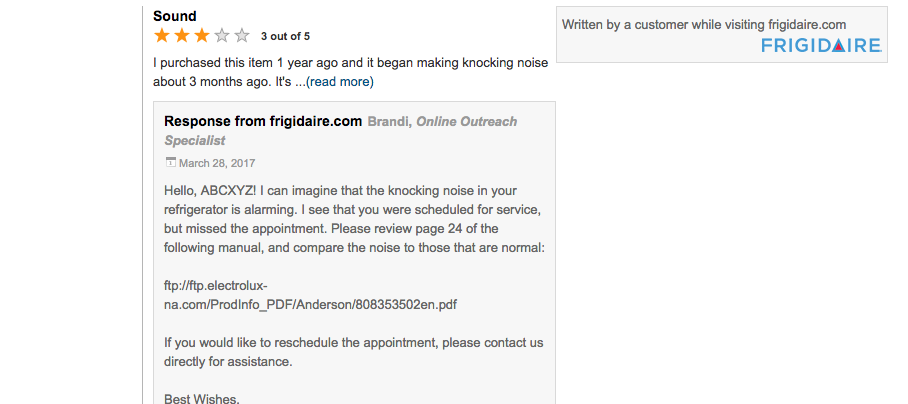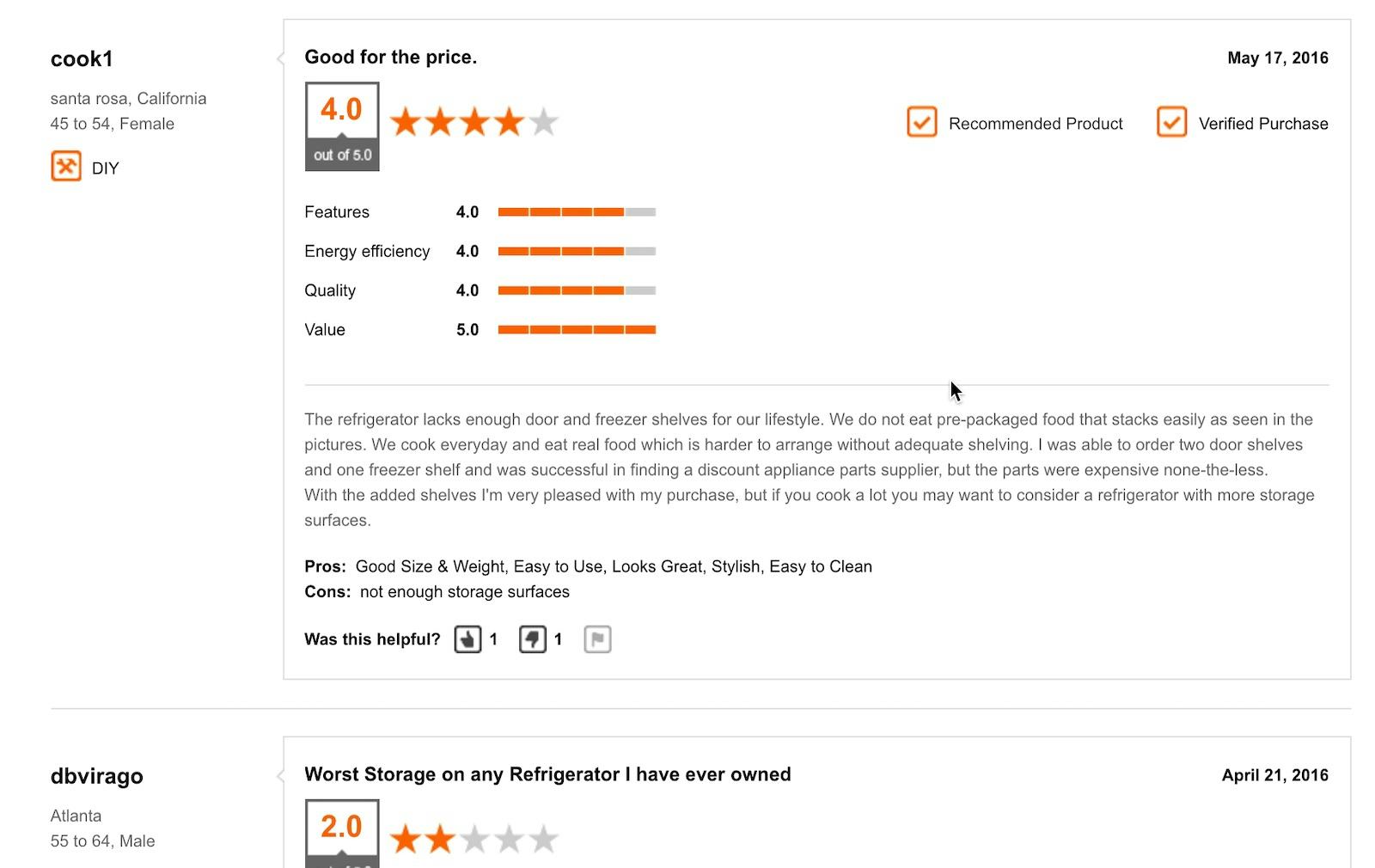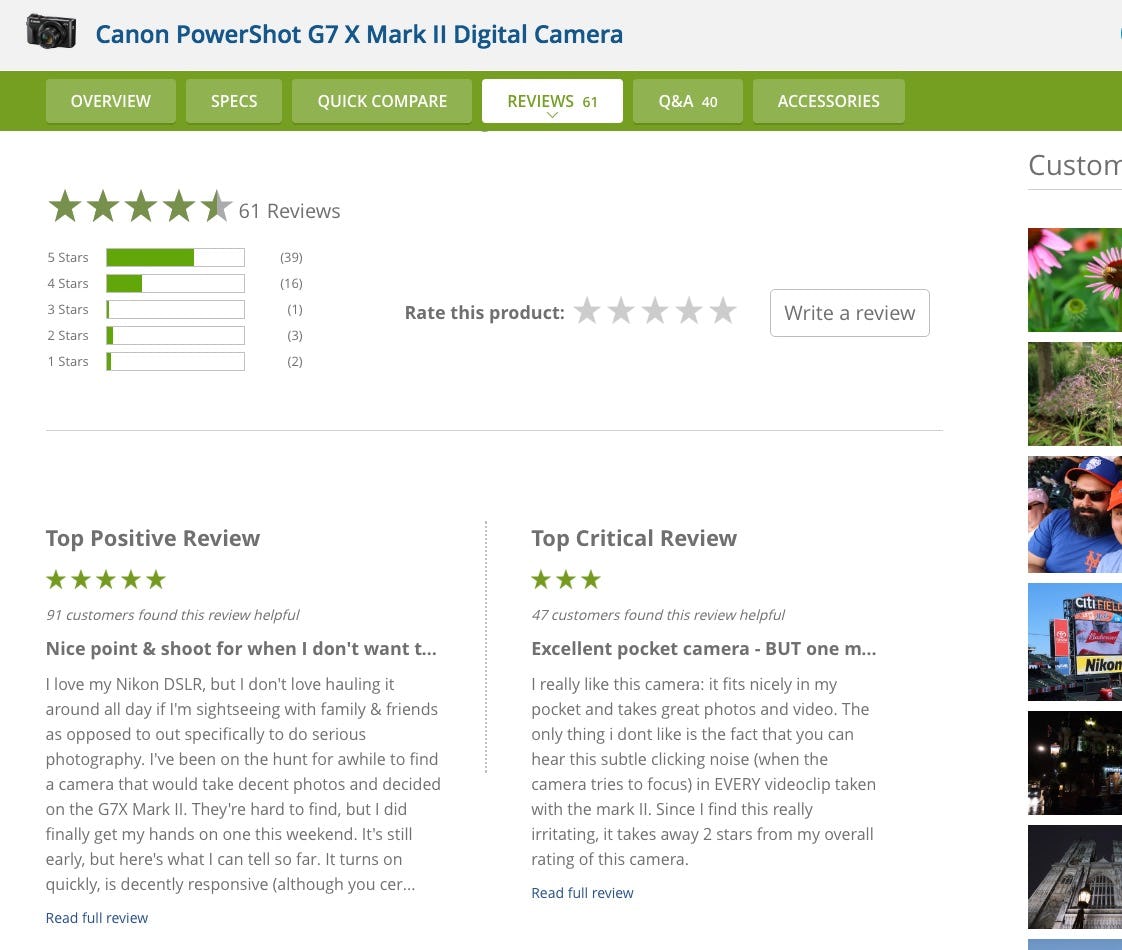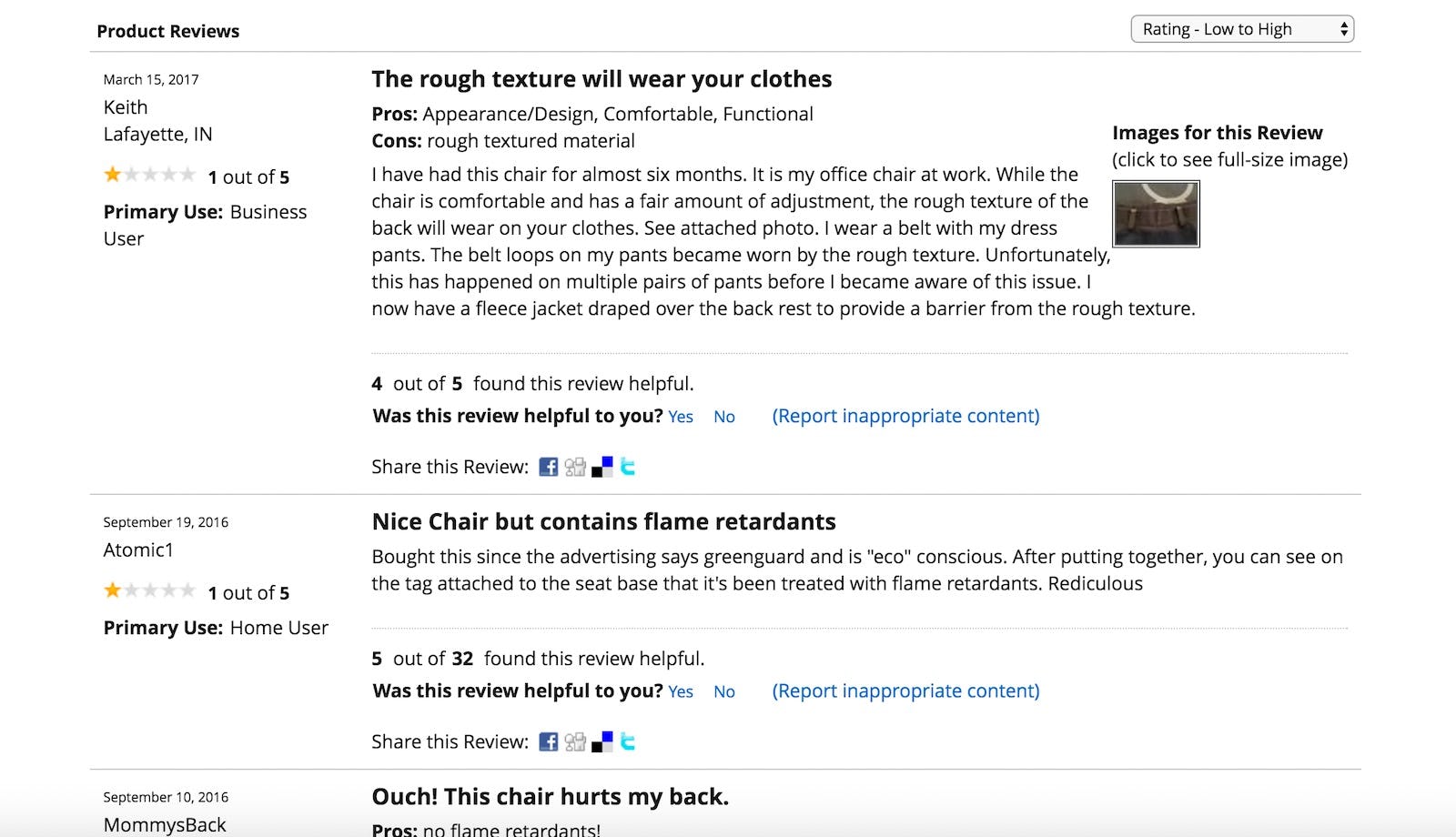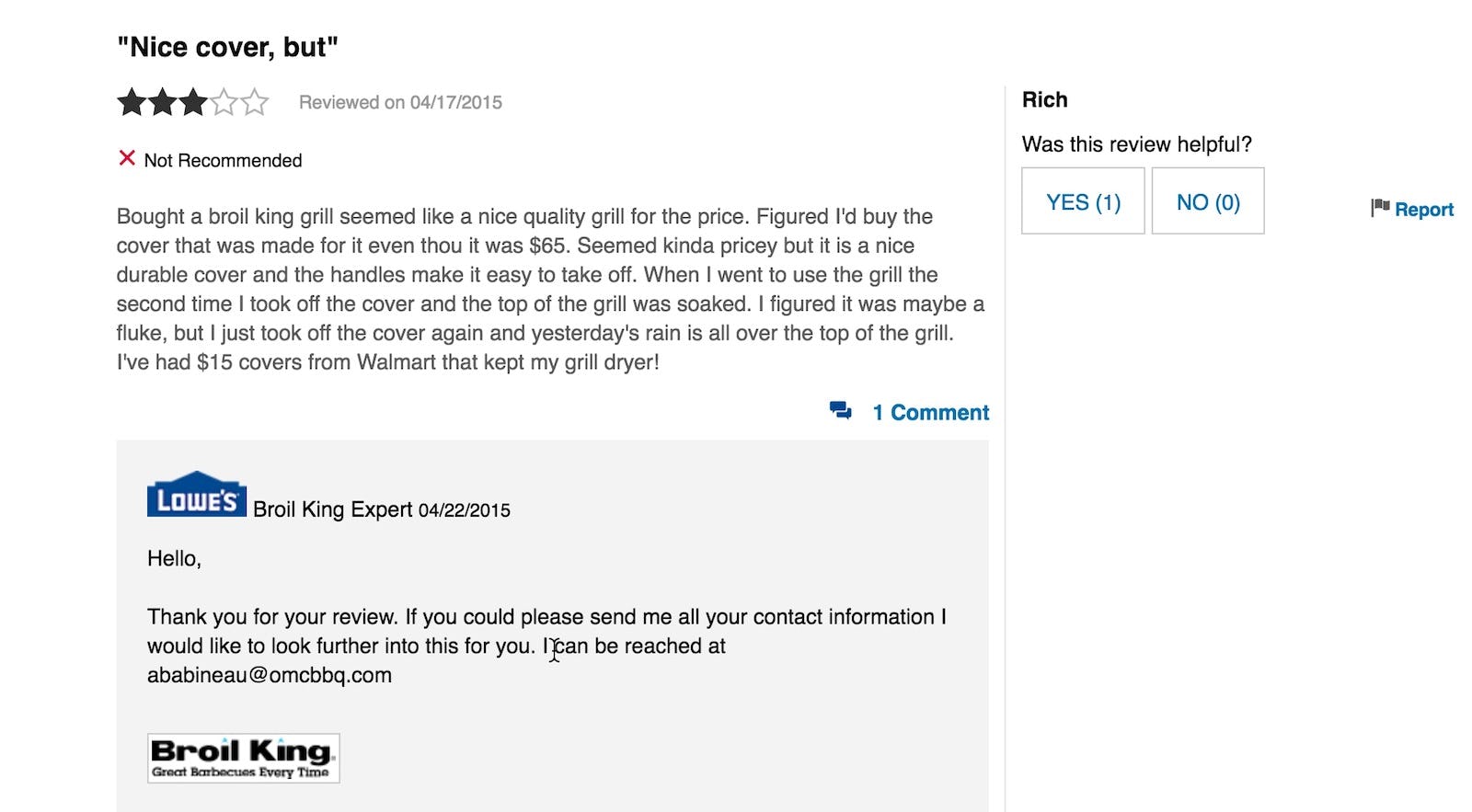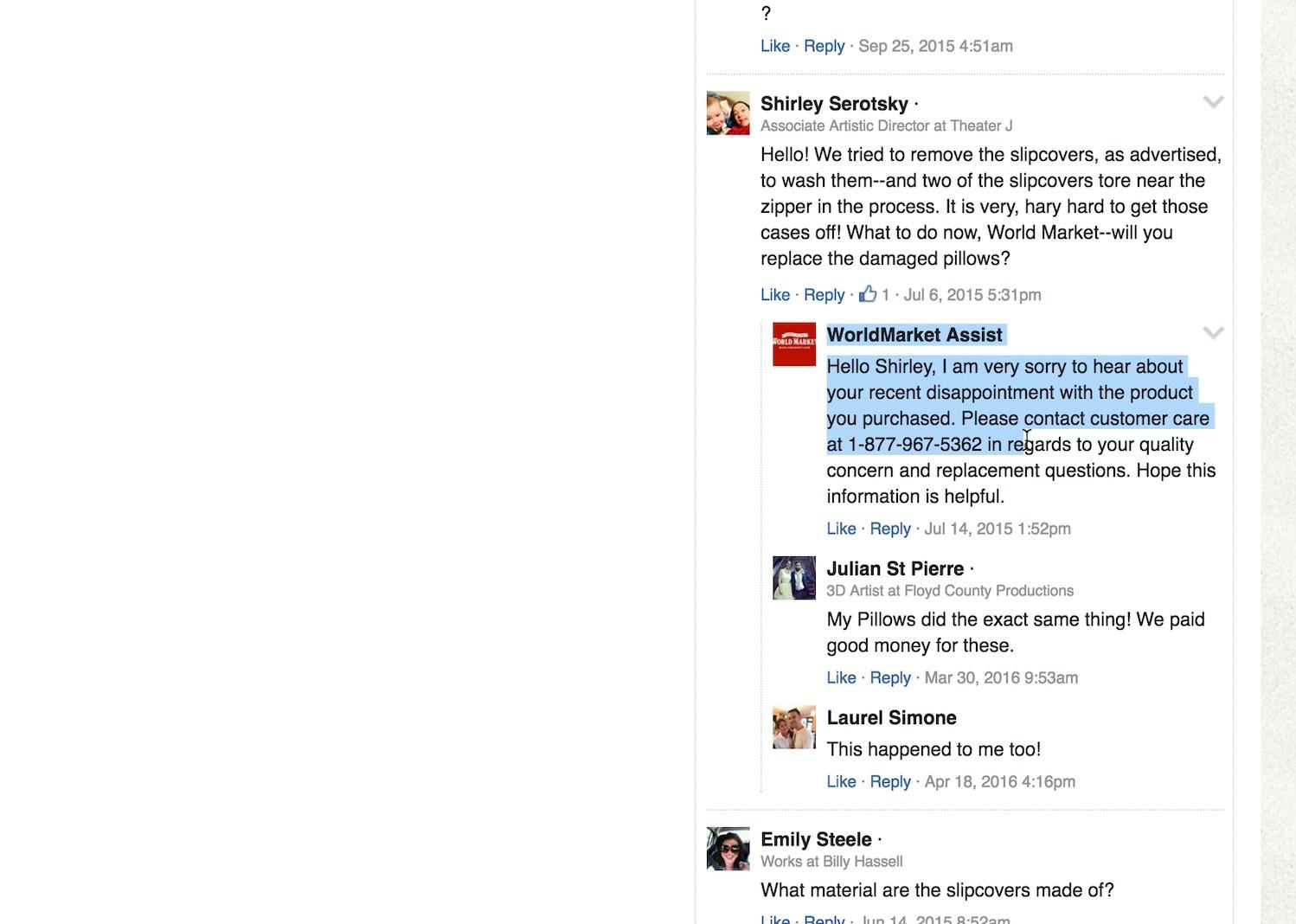User Reviews aren’t just important — they are critical to users’ purchasing decision, and to users’ ability to even make an informed purchasing decision.
During our large-scale product-page usability testing, 95% of users relied on reviews to evaluate or learn more about products. In some cases users would even rely on the review descriptions instead of the information provided by the site (product descriptions or spec sheets). We find that after the product images, user reviews are actually the most utilized part of the product page when users are trying to evaluate a product’s suitability.
With this in mind, it’s vital to allow users to submit product reviews on a site (which 92% of e-commerce sites do). But that’s not enough. Users are very likely to sort or filter customer reviews to view the negative reviews, not just the positive ones. In fact, we observe on average and across e-commerce sites in our testing that 53% of users specifically seek out the negative reviews for one or more products they are interested in. Because of this, the likelihood of users processing some negative reviews for the specific product they are viewing is very high.
“I don’t want to just read the perfect reviews. I want to see what its shortcomings are.” A user said, while clicking the ratings distribution summary in order to filter ratings by three-star reviews. 53% of users specifically seek out the negative reviews on e-commerce site.
More importantly, our testing also shows that 37% of users positively factor in any site responses to negative reviews into both their evaluation of the negative review, their overall evaluation of the product, and their overall perception of the site. Yet, our benchmarking reveals that 87% of e-commerce sites don’t respond to the negative reviews, not even on their most popular products sold.
In this article, we’ll discuss some of our test findings from our Product Details Page usability studies related to negative user reviews, including:
- Why negative reviews aren’t all that bad
- Why e-commerce sites should reply to negative reviews
- How to style the site’s responses to negative reviews
Why Negative Reviews Aren’t all that Bad
Negative reviews are inevitable. Even the strongest brands and the most loved companies will not be able to please everyone all the time. But, not all negative product reviews are bad for the e-commerce site. They do, in fact, have their uses.
A user at Lowe’s looked through negative reviews seeking a pattern and noticed issues with the ice maker. “Now the ice dispenser is becoming interesting because it’s the second person with an ice issue. But I don’t care about the ice dispenser anyway.” Since it was not an important feature to her, the negative reviews were less impactful to her.
A negative review may simply let a subset of users know whether or not a product is suited to their needs. Repeatedly in our testing, users scanned the negative reviews as part of their “purchase due diligence process”, confirming that the negative reviews were only addressing aspects that weren’t important to what they were looking for (i.e. a user stating that vacuum does not handle pet hair would not be that important to someone that doesn’t own a pet).
Because users will want to seek out negative reviews, it’s critical to offer users the ability to use the rating distribution summary as “star filters”.
“Hmmm…“Worst storage of any refrigerator I’ve ever owned” a user read aloud when looking through the first handful of diverse reviews at Home Depot. Seeing another, the user said, “OK, so this guy also said it was a storage thing, I might just leave now, because I’m getting a lot of….even the 4’s, they are kind of giving it a not great review.” The mixed reviews accurately portrayed the product, allowing the user to more quickly dismiss the product and move on to another more relevant product.
B&H Photo goes as far as highlighting negative reviews at the top of the reviews section. In this case, a user unconcerned with the video capabilities of the camera would likely not let this review negatively impact their evaluation of the camera. Users concerned with the video capabilities are likely better off choosing one of the hundreds of other cameras offered at the site.
Negative reviews serve several important functions for an e-commerce site:
- They help users succeed in finding the right product (for them). In the user’s product exploration process, quickly being able to dismiss non-matching products (based on information in a negative review) can help speed up the process of locating another alternative product on the site, and make users confident enough in the newly chosen alternative that they go ahead and place the order. For standard e-commerce sites that carry multiple brands, it is better to guide users to the product the specific users will be pleased with in the long term, instead of coaxing them into a sub-optimal choice now.
- Negative reviews increase trustworthiness of the overall product rating. We observe that users commonly seek out negative reviews because they do not trust only positive reviews. As in, negative reviews create an authentic context for all reviews, as explored in our article “Users’ Perception of Product Ratings — Qualitative & Quantitative Findings”.
- Negative reviews are an important feedback mechanism. Lastly, negative reviews carry a wealth of important information. For sites selling multiple brands, the negative reviews help the site identify products or brands that they should stop carrying entirely, or highlight gaps in their product offering. For single-brand e-commerce sites (who sometimes face substantial internal objections of even allowing customer reviews at their site at all, mainly fearing the possibility for negative reviews) negative reviews can help product development identify new options for revision of existing products, help manufacturing to discover sudden quality issues early on, and help management to act more quickly in discontinuing products that are a complete miss before they do permanent brand damage.
Most importantly, while sites are powerless over what negative reviews will be submitted and what those negative reviews will say — our testing shows that sites do have a lot of control over how negative product reviews will impact other users’ perception of the site and brand itself.
Why Sites Should Reply to Negative Reviews
Responding to negative reviews marks an opportunity for sites to mitigate potentially damaging sentiments left by a reviewer. Our testing shows that when company responses were provided on negative reviews, 37% of users factored the site’s response positively into their evaluation of the negative review, their evaluation of the product, and their evaluation of the e-commerce the brand itself.
Office Depot’s and Walmart’s lack of response to negative reviews could harm the perception of the site and deter users from purchasing certain products, or possibly any product, from the site.
However, some reviews, if left unchecked, can have severely negative effects. Because reviews don’t just focus on product attributes, but also a product breaking or external circumstances surrounding the product (e.g. shipping, customer service, or an in-store experience), a review may reach beyond just the product details and affect a user’s opinion about the e-commerce site and company itself.
“He wrote this on April 17. and he got a reply on April 22…I feel more comfortable with this product and Lowe’s as a company. I know that if another product I buy has this problem they are gonna do their best to solve the problem. It just dissuades me from that one product, it does not dissuade me away from Broil King as a whole.” A user was confident in purchasing from Lowe’s and with the Broil King brand after reading the site’s response to a negative review.
A different user at a single-brand e-commerce interpreted a site’s response as an indication of product improvement. “I really appreciate when the company responds to negative reviews. I feel like they will change the product eventually or have really good customer service. I will sometimes overlook negative reviews if I feel like they are responding to them.”
Using reviews as a tool for proactive customer service or to facilitate conversation is where the benefits of responding to reviews starts extending into other areas. Unlike a dissatisfied customer calling customer service, a site’s response to a negative review is broadcasted to all future users who scans through the review section.
Even if a response to a negative review does not change the dissatisfied customer into a satisfied one, it does have the positive attribute of showing new users that the company does “care” and offers an easily reachable customer support. This can disarm users upfront purchasing anxiety, of fearing the scenario of ending up with a malfunctioned product and not being able to get help or a replacement.
During testing, users repeatedly noted when sites responded to reviews, explicitly stating that responses made them think more highly of the company. For e-commerce sites that sell multiple different brands, a review may reflect negatively on only one product, but a site’s response to a review may keep users on the site, to find an alternative product.
Even if unable to solve a user’s issue, a review response can still correct a reviewer’s misperceptions or inaccurate report (so it doesn’t spread to other users), or assure users about the ease of returns or service, along with simply maintaining brand integrity.
Understandably, responding to all negative reviews may be unfeasible with particularly large catalogs and a very active review base. Ideally, all negative users should be responded to in some way. But if not possible, e-commerce sites should ensure at the least that negative reviews on popular or important products are replied to, along with products where the proportion of negative to positive reviews are heavily skewed. For single brand sites, the stakes for how other users will interpret the negative reviews are higher, and a more methodological response policy for all negative reviews will often be worthwhile.
How to Style the Site’s Responses to Negative Reviews
In order for site responses to be helpful, they should be noticeable, and easy to discern from the review itself. Responses that look too much like reviews can be easily dismissed or overlooked by users, canceling out any benefit of having them there in the first place.
There are various ways a site can make the difference between a user review and a site response clear, including:
- Using an indentation (to visually nest the response within the review it belongs to)
- Showing the response in a different styling, e.g. a different background color, different font styling, etc.
- Including company logos or “staff” titles (these were shown in testing to be effective design tools to differentiate the review response from the review)
These are just some of the options available to help the user differentiate between what they’re reading. We observe in testing that the exact type of styling is not crucial, it’s just key to somehow make the information as scannable and easy to recognise as possible.
Positive Results from Negative Reviews
Though the occasional negative review is inevitable, e-commerce sites have some control over what that negative review does to the product and the e-commerce brand. Even negative reviews have their place and their uses on e-commerce sites, and embracing them allows the site to control the story.
Considering that 53% of users specifically seek out negative reviews and 37% of users factor in the site’s response into their evaluation of the brand and the product, it’s detrimental to ignore them. This means that the 87% of e-commerce sites that aren’t responding to negative reviews are missing out on an opportunity to help their users.
When it comes to user reviews and responses, remember to:
- Allow all users to submit user reviews (8% of sites currently don’t).
- Respond to all (or at least some) negative reviews, especially on popular products (87% of sites currently don’t).
- Style the site responses differently so it’s clear that it’s a reply and not just another user’s review.
This article presents the research findings from just 1 of the 650+ UX guidelines in Baymard Premium – get full access to learn how to create a “State of the Art” e-commerce user experience.
